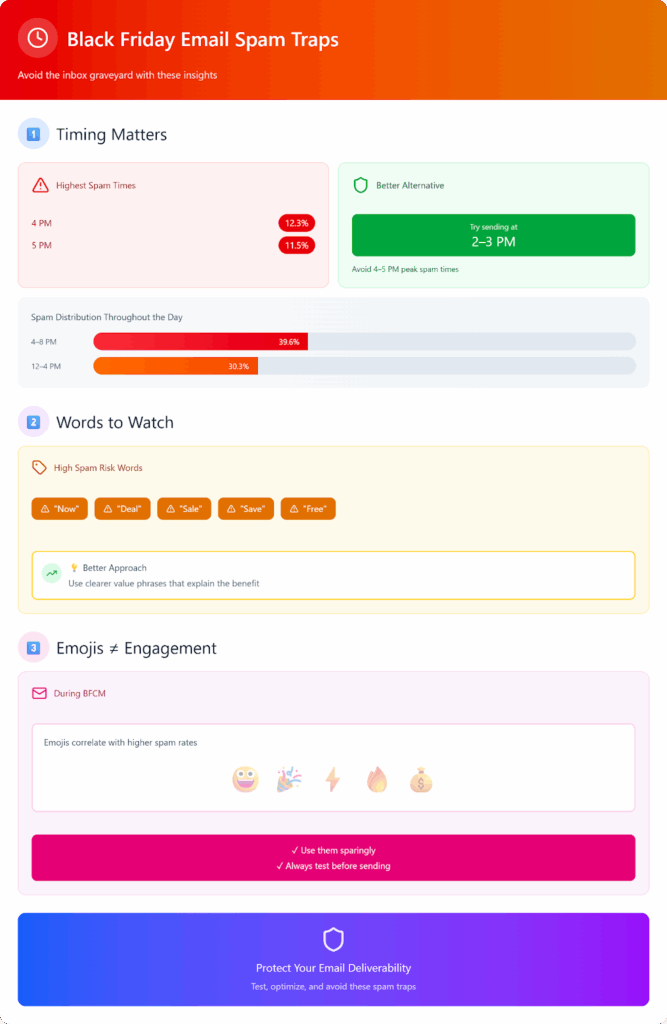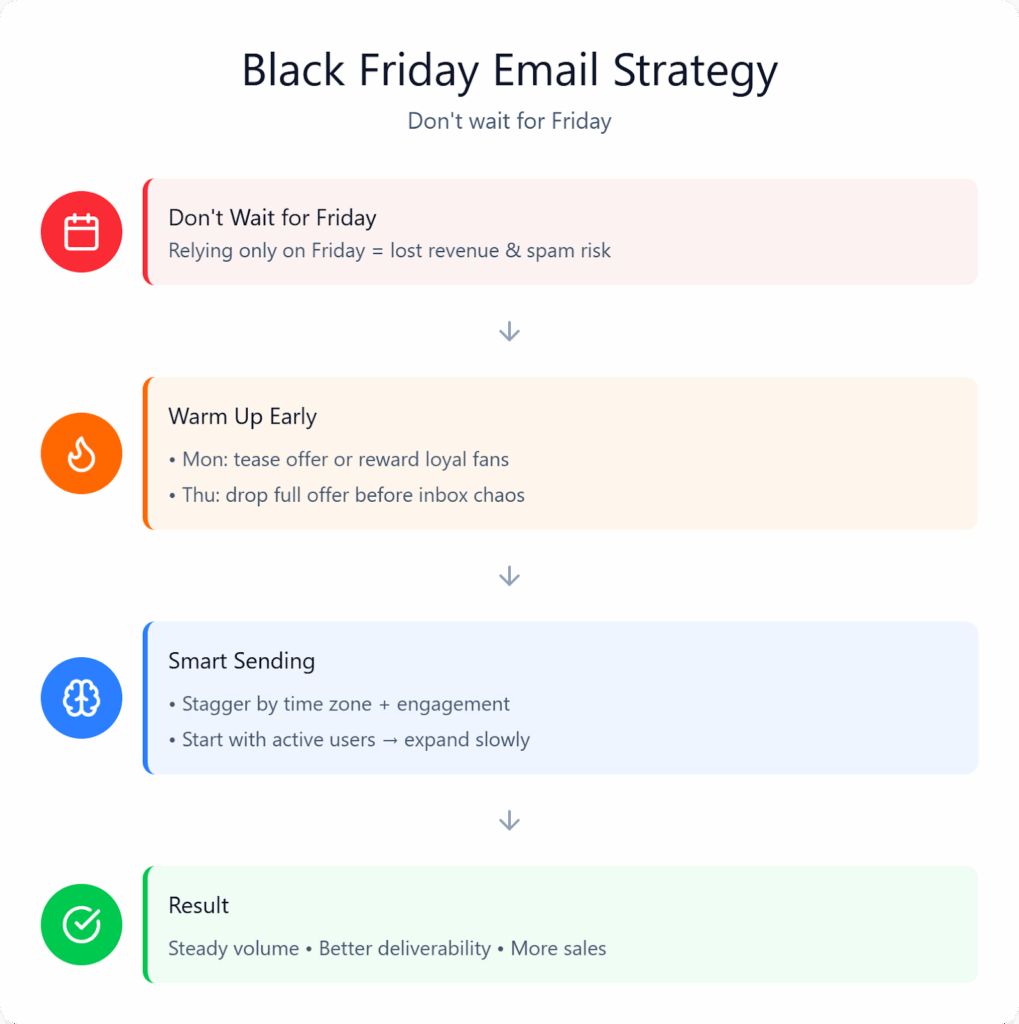Quick Summary
Send early afternoon. The Best Time To Send Black Friday Email is 1–3 PM local time, with 1 PM showing the strongest inbox placement.
Avoid 4–5 PM, which has the highest SPAM placement.
Friday is the biggest day and still worth targeting — anchor your main send for Friday 1–3 PM.
Warm your audience on Monday and Thursday.
Watch your subject lines, steer clear of common spam triggers and emojis, and tighten your segmentation to protect deliverability when competition peaks.
Black Friday is a unique challenge every year. Competition is high, offers are everywhere, and inboxes fill up fast.
Our data shows that about 91% of Black Friday emails end up in the Promotions tab, while only around 1.5% reach the primary inbox.
With so many brands sending messages at the same time, timing becomes an important part of your deliverability strategy. Choosing the right hour to send can make the difference between being seen and getting lost in the noise.
Why timing matters for BFCM deliverability
We analyzed 5,025 Black Friday emails from 1,404 brands across 399 days. The dataset covered discount blasts, urgency pushes, promotions, and a mixed “other” bucket to reflect the variety of BFCM tactics ecommerce teams actually send.
The headline: inbox real estate is scarce during Black Friday. Only 1.53% of all emails reached the primary inbox, while 7.28% landed in spam, and the overwhelming majority, 91.18%, were filtered to Promotions.
If your campaign depends on being seen right now, timing is one of the few levers you still fully control alongside list hygiene, authentication, and content choices.
Timing also interacts with content. Black Friday Email Spam risk rises when subject lines over-index on trigger words.
In our sample, the most common spam-triggering terms were “now,” “deals,” “Sale,” “Save,” “free,” “exclusive,” and “buy.” Nearly half of spammed emails (45.9%) also used emojis in the subject line.
When competition is fierce and filters are tight, squeezing every marginal gain out of timing and tone yields outsized returns.
Inbox placement patterns by hour
Even with most emails diverted to Promotions, the small subset that did hit the inbox shows an important pattern by hour.
The most common inboxing hour was 1 PM, which accounted for 14.29% of inboxed sends, followed by 5 PM at 9.09%. This suggests an early afternoon “readiness window” when subscribers are receptive and mailbox providers are more tolerant of volume.
If you want the simplest playbook, prioritize 1 PM in each subscriber’s local time. This respects time zones, reduces sudden global spikes, and aligns your offer with a mid-day check-in moment.
If your email platform supports time-zone–aware sending and batching by engagement level, use it to stagger deployments and avoid a single large burst that could look risky to filters.
SPAM risk hours to avoid
The hours you skip matter as much as the hours you choose. Our dataset shows the highest spam placement at 4 PM (12.30%) and 5 PM (11.48%).
Looking at wider windows, 39.62% of all spam placements clustered between 4–8 PM, while 30.33% happened between 12–4 PM. Late afternoon is where good offers go to die.
Avoid sending at 4–5 PM whenever possible. If your audience skews late-day openers, experiment with 2–3 PM and monitor results, but treat 4 PM as a last resort.
Beyond timing, reduce Black Friday Email Spam risk by tightening your email subject lines. Moderating trigger words like “now,” “deals,” “Sale,” “Save,” and “free” can help, and swapping emojis for clear value statements can protect placement.
Emojis aren’t forbidden, but during Black Friday, they correlate with higher spam rates, so use them sparingly and test their impact on engaged segments first.

Most-used send days (competition levels)
Friday is the main event. It accounted for 25.29% of all sends in our sample. Monday came next at 14.95%, followed by Thursday at 13.69%.
That concentration means Friday’s inboxes are crowded, and mailbox providers are extra vigilant. Your subject lines, segmentation, and timing must work harder to stand out without tripping filters.
Expect heightened Promotions filtering on Friday, and plan to earn your open with specificity. Promise a concrete benefit, reflect product relevance, and keep your subject credible.
Pair targeted audiences with tailored offers. Discount-driven and urgency themes dominated the mix: 22.67% discount, 20.70% urgency, 19.86% promotions. So if your subject blends generic urgency with a generic discount, you’ll look like everyone else at the worst possible moment.
Proven inbox window on the biggest day
Within emails that reached the inbox, Friday owned the largest share by day, and the strongest two-hour window was 1–3 PM, which captured 201 inboxed messages out of Friday’s 1,276 inboxed sends.
That’s the most defensible window when the stakes are highest.
Anchor your primary Black Friday campaign for Friday, 1–3 PM local time. If your brand sells across multiple time zones, stagger by region and send to your most engaged segments first, then expand.
If you have a secondary Friday blast, position it earlier in the day, and keep the 4–5 PM window off-limits unless data compels otherwise.
Backup windows and a smart spread strategy
Relying entirely on Friday can leave revenue on the table and risk your reputation if you surge volume too quickly.
Use Monday and Thursday to preheat demand, introduce your offer, and gather engagement signals.
On Monday, warm your audience with a teaser, an early access angle, or a loyalty-first perk. On Thursday, land your full offer for early birds and high-intent shoppers who want to avoid Friday’s flood.
Both days face less competition, making them ideal for segmentation tests, creative refinements, and deliverability checks before your main send.
Stagger sends by time zone and engagement tier. Start with customers who have opened or clicked in the last 30–90 days to establish positive signals, then widen your net.
This pacing smooths volume spikes and reduces sudden changes that filters may flag.

Deliverability guardrails for BFCM
Think of deliverability as a safety net that makes your timing strategy pay off. Before you schedule your Friday hero campaign, tighten the fundamentals that influence inbox placement.
Authenticate your domain with SPF, DKIM, and DMARC and keep your sending identity consistent.
Calibrate your volume ramp in the week leading up to Black Friday, rather than jumping from low send frequency to a giant blast. Lean into engaged segments first, then expand thoughtfully.
Establish sunset rules for unengaged contacts, and suppress addresses that haven’t opened in months to avoid negative engagement signals.
Reduce spam risk in your subject lines by swapping trigger-heavy language for clear value.
Instead of “Exclusive DEALS now! Save FREE!” use concise, specific statements about the outcome or product category, ideally tailored to buyer behavior. Given the 45.9% emoji correlation among spam placements, test no-emoji variants for your most important sends.
Keep a close eye on outcomes during BFCM. If opens dip or spam complaints rise, pull back volume, tighten your segments, and shift your next send to the earlier 1–3 PM window.
If your test group shows better inboxing at 1 PM than 2 PM, bias your rollout accordingly. Agility is an advantage when the competitive set changes hour by hour.
If you manage campaigns in TargetBay Email & SMS, use time zone–aware scheduling, segment-level throttling, and quick creative variants to pivot fast.
Pair email with SMS reminders for high-intent segments during your proven window to reinforce visibility without overloading inboxes.
Why timing interacts with content and intent

Timing doesn’t work in isolation. The same message sent at 1 PM and 4 PM performs differently, but performance also shifts by the promise you make and how well it aligns to buyer intent.
Discount and urgency themes dominated our dataset, which means inboxes are full of similar pitches. A well-timed email that adds specificity, trust, and relevance is more likely to earn a primary tab placement or a top position in Promotions.
Focus on outcome-focused subject lines, clarity over hype, and brand consistency. Use your pre-Friday sends to seed context, then let Friday’s 1–3 PM drop deliver the definitive offer.
For repeat purchasers and loyalty members, emphasize exclusivity through account-specific perks.
For new subscribers, build credibility with social proof and clear product benefits rather than leaning on generic “deals” messaging that can set off Black Friday Email Spam filters.
Putting it together: a sample BFCM cadence
Start with Monday. Warm your engaged audience, tease the offer, and invite early access for your best customers. Use this send to validate segments and collect engagement signals.
Follow with Thursday. Deliver an early window for loyal buyers and highly active subscribers. Keep subject lines clean, reduce trigger words, and send in the early afternoon to train providers on positive engagement ahead of Friday.
Finish strong on Friday. Anchor your hero send at 1–3 PM local time. Lead with the clearest value you can promise, then reinforce with SMS or a narrowly targeted second email earlier in the day.
Avoid the 4–5 PM slot and keep a close watch on placements. If performance dips, pivot your next touch to your proven hour and tighten your audience.
The bottom line
Across 5,025 emails from 1,404 brands, one pattern consistently stood out: the Best Time To Send Black Friday Email is early afternoon, with 1 PM local time offering the most reliable path to the inbox and 4–5 PM carrying the heaviest spam risk.
Combine that timing insight with restrained, value-first subject lines, disciplined segmentation, and a spread strategy that warms your audience on Monday and Thursday. Even in a market where most messages are filtered to Promotions, these choices compound into real revenue.
Coordinating timing, messaging, and segmentation is easier when your stack is unified. With TargetBay Email & SMS handling time zone–aware sending and quick testing, TargetBay Reviews powering trust signals, and TargetBay Rewards reinforcing loyalty offers, you can launch smarter, faster, and with fewer moving parts, right when it matters most.
Frequently Asked Questions
What time to send Black Friday email?
Early afternoon performs best. Aim for 1–3 PM in each subscriber’s local time, with 1 PM showing the strongest inbox placement in our data. This window balances readiness to engage with a lower risk of Black Friday Email Spam placements compared to late afternoon.
Should you send emails on Friday?
Yes. Friday is the most active day, and the top inbox window is Friday 1–3 PM. Expect intense competition, so tighten your segments to favor engaged contacts and avoid heavy-handed subject lines. Use Monday and Thursday to warm your audience and reduce Friday’s risk.
What are the best times to send an email blast on Friday?
Target 1 PM first, then 2–3 PM if your list spans multiple time zones. Avoid 4–5 PM due to elevated spam placement rates. If you must send a second Friday touch, position it earlier in the day and keep the creative simple and specific.




